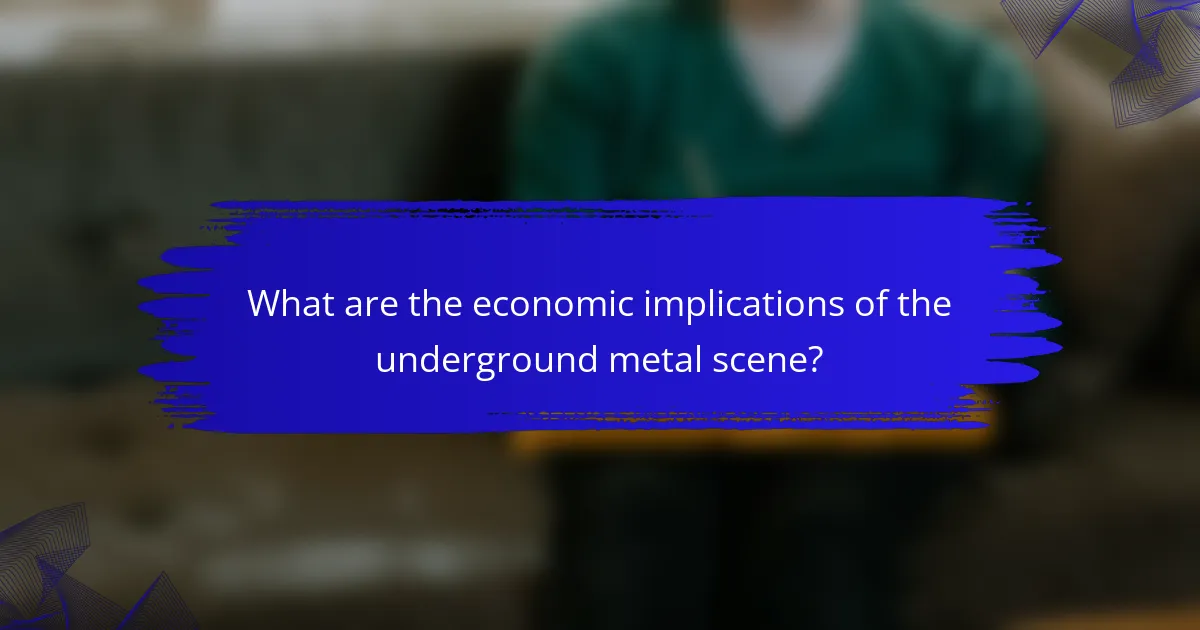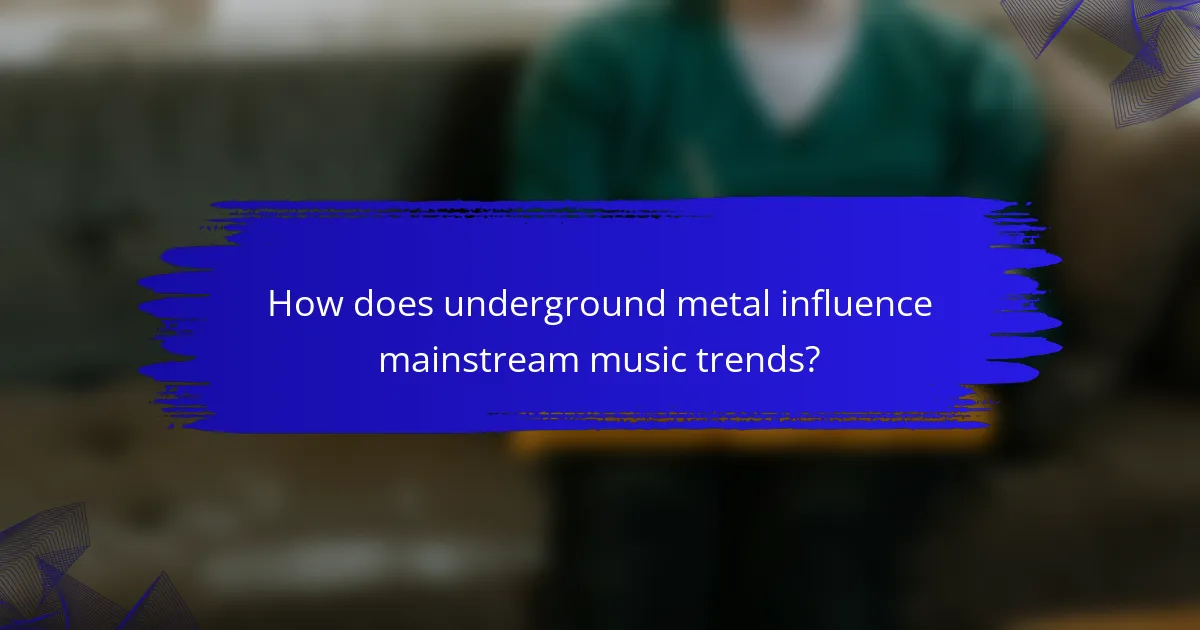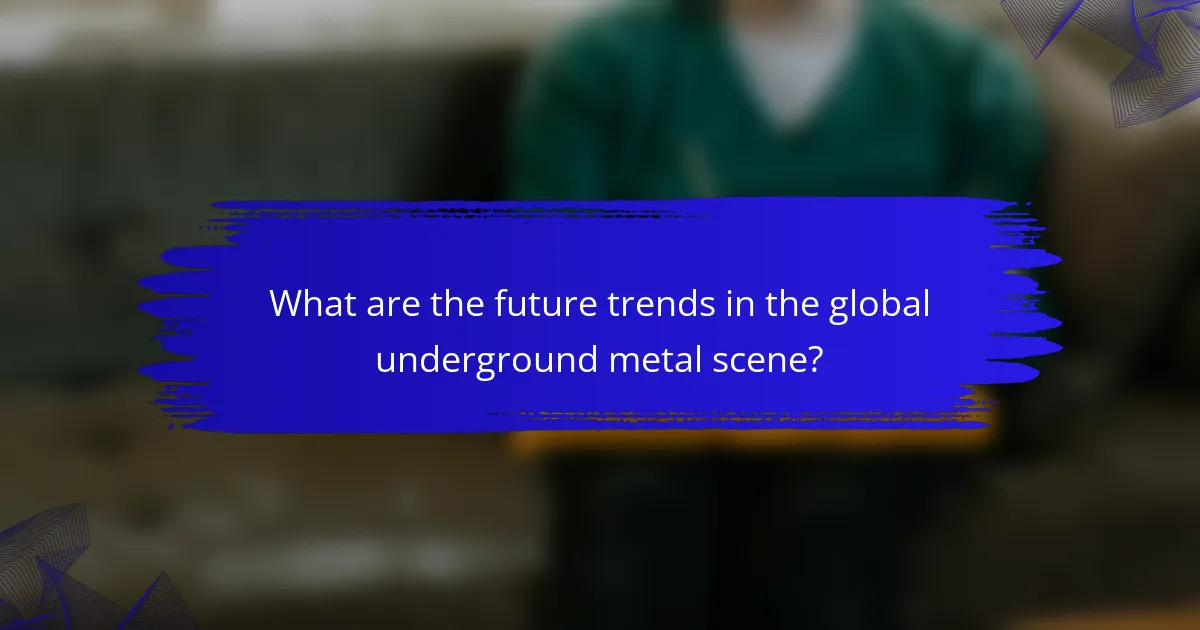Underground metal has become a global cultural force, uniting diverse communities through music. The rise of the internet enables international connections, allowing bands to reach wider audiences. Cultural exchanges create unique sounds by blending local traditions with metal. Local scenes and festivals foster innovation and community, while social media amplifies visibility and engagement. Additionally, underground metal influences social movements and shapes mainstream music trends, reflecting broader cultural shifts.

How has underground metal evolved as a global cultural phenomenon?
Underground metal has evolved into a global cultural phenomenon through diverse cultural exchanges and influences. This genre transcends geographical boundaries, fostering a community that shares a passion for music and values.
The rise of the internet has played a critical role in this evolution, enabling fans and musicians to connect globally. Platforms like Bandcamp and SoundCloud allow underground metal bands to reach international audiences without traditional record label support.
Cultural exchange is evident in the fusion of styles, with bands incorporating elements from various musical traditions. For instance, Asian metal bands often blend local folk music with heavy metal, creating unique sounds that resonate with both local and global fans.
Moreover, festivals dedicated to underground metal have gained international prominence, attracting diverse audiences. Events like Wacken Open Air in Germany showcase bands from around the world, promoting cultural exchange and solidarity within the metal community.
What are the defining characteristics of underground metal across different cultures?
Underground metal exhibits defining characteristics that vary across cultures, reflecting local influences and traditions. Key elements include distinct musical styles, lyrical themes, and community values.
For example, Scandinavian black metal emphasizes themes of nature and mythology, while Latin American metal often incorporates local folklore. In Japan, the fusion of traditional instruments with heavy metal creates a unique sound that showcases cultural heritage.
The DIY ethic in underground scenes fosters a sense of community, promoting local bands and venues. This grassroots approach enhances cultural exchange, allowing different influences to merge and evolve.
Overall, the diversity of underground metal highlights its ability to adapt and resonate within various cultural contexts, making it a rich and dynamic genre globally.
Which key subgenres have emerged in various regions?
Several key subgenres of underground metal have emerged across various regions, reflecting unique cultural influences. In Europe, black metal has gained prominence, particularly in Scandinavia, characterized by its atmospheric sound and themes. In South America, thrash metal has thrived, showcasing aggressive rhythms and socio-political lyrics. The United States has seen the rise of death metal, known for its complex structures and growled vocals. Asia, particularly Japan, has introduced genres like visual kei, blending metal with theatrical elements. Each subgenre highlights distinct regional characteristics while contributing to the global underground metal scene.

What role do local scenes play in the global underground metal community?
Local scenes are vital to the global underground metal community as they foster cultural exchange and influence. These scenes create unique environments where local bands can thrive, share their music, and connect with global audiences. They often serve as incubators for innovation, blending diverse musical styles and traditions. For example, a local scene in Brazil might incorporate samba rhythms into metal, creating a distinctive sound that influences international artists. Additionally, local festivals and shows enhance community bonds while promoting underground talent, further amplifying their reach.
How do regional festivals contribute to cultural exchange?
Regional festivals foster cultural exchange by bringing diverse communities together, promoting understanding and collaboration. These events showcase local traditions, music, and art, allowing participants to experience different cultures firsthand. For instance, underground metal festivals often feature bands from various countries, creating a platform for cross-cultural dialogue. This interaction not only enriches the attendees’ experiences but also strengthens global networks within the metal community. As a result, regional festivals play a crucial role in preserving cultural heritage while encouraging innovation through shared influences.
What are the unique challenges faced by underground metal bands in different countries?
Underground metal bands face unique challenges in different countries, shaped by cultural, legal, and economic factors. In regions with restrictive governments, bands often struggle with censorship and limited performance opportunities. Economic instability can hinder access to quality equipment and venues, impacting the overall sound quality and reach. Cultural acceptance varies significantly; in some countries, metal music is embraced, while in others, it faces stigma. Additionally, language barriers can complicate communication and marketing efforts. These challenges create a diverse landscape for underground metal, influencing how bands adapt and thrive globally.

How do social media and streaming platforms influence underground metal’s reach?
Social media and streaming platforms significantly expand underground metal’s reach by connecting niche audiences globally. These platforms facilitate cultural exchange, allowing fans to discover diverse subgenres and artists. For example, YouTube and Bandcamp enable artists to share their music widely, breaking geographical barriers. As a result, underground metal garners increased visibility and a growing fanbase, fostering a vibrant community. Streaming services also provide data analytics, helping artists understand their audience and tailor their outreach effectively.
Which platforms are most popular among underground metal fans in different regions?
Social media platforms, Bandcamp, and SoundCloud are popular among underground metal fans globally. In Europe, platforms like Facebook and Instagram foster community engagement. In North America, Bandcamp’s direct artist support is significant, while in South America, YouTube serves as a key discovery tool. In Asia, regional platforms like Weibo gain traction, reflecting local preferences. Each region showcases unique interactions with underground metal culture.
How do algorithms shape the discovery of underground metal music?
Algorithms significantly enhance the discovery of underground metal music by analyzing listener preferences and trends. They curate personalized playlists, recommend similar artists, and connect fans across geographical boundaries. This cultural exchange fosters a global community, allowing niche genres to thrive. Unique algorithms can identify emerging sub-genres, highlighting artists who might otherwise remain unnoticed. As a result, underground metal gains visibility and influence, reshaping its presence in the broader music landscape.

What impact does underground metal have on social and political movements?
Underground metal significantly influences social and political movements by fostering community, expressing dissent, and promoting cultural exchange. This genre often serves as a voice for marginalized groups, addressing issues like inequality and injustice. Bands frequently tackle political themes in their lyrics, galvanizing fans to engage in activism. For instance, the global underground metal scene has united diverse cultures, creating a shared platform for resistance against oppression. This cultural exchange enriches the genre and strengthens the impact of its messages.
How do underground metal lyrics reflect cultural and societal issues?
Underground metal lyrics often reflect cultural and societal issues by addressing themes like oppression, inequality, and rebellion. These lyrics serve as a voice for marginalized communities, highlighting struggles against political and social injustices. For example, many bands tackle topics such as war, poverty, and discrimination, creating a powerful commentary on contemporary society. This genre’s global reach fosters cultural exchange, allowing diverse perspectives to influence and enrich the underground metal scene. As a result, the music becomes a medium for social critique, resonating with listeners across various backgrounds.
Which bands have become symbols of resistance in their respective countries?
Several bands have become symbols of resistance in their countries, often reflecting social and political struggles. For example, Rage Against the Machine in the United States embodies anti-establishment sentiments. In Brazil, Sepultura addresses issues like inequality and environmental concerns. In Russia, Korol i Shut critiques government repression through their lyrics. These bands illustrate how underground metal can serve as a voice for dissent and cultural identity.

What are the economic implications of the underground metal scene?
The underground metal scene significantly impacts local economies by fostering cultural exchange and generating income. This genre drives tourism, as festivals attract fans globally, boosting local businesses. Merchandise sales and venue revenues also contribute to economic growth.
The scene promotes job creation in music production, promotion, and event management. Local artists gain exposure, leading to unique collaborations and cultural innovation. Additionally, the underground metal community often supports local charities, enhancing social responsibility and community engagement.
As a result, the economic implications extend beyond music, influencing cultural identity and regional development. The underground metal scene exemplifies how niche genres can have broad economic and cultural effects.
How do underground metal bands sustain themselves financially?
Underground metal bands sustain themselves financially through a combination of merchandise sales, crowdfunding, touring, and digital platforms. These revenue streams allow them to maintain their artistic independence while reaching global audiences.
Merchandise sales contribute significantly to their income, with unique designs appealing to dedicated fans. Crowdfunding platforms enable bands to finance projects directly through fan support, fostering a sense of community. Touring remains essential, as live performances generate revenue and enhance visibility.
Digital platforms like Bandcamp and Spotify provide additional avenues for income, allowing bands to distribute music globally. The cultural exchange within the underground metal scene further amplifies their reach, as collaborations and genre-blending attract diverse audiences.
These financial strategies highlight the resilience of underground metal bands, showcasing their ability to thrive despite challenges in the music industry.
What role do independent labels play in promoting underground metal?
Independent labels play a crucial role in promoting underground metal by providing platforms for emerging artists. They facilitate cultural exchange and influence through niche marketing and community engagement. Independent labels often prioritize artistic integrity over commercial success, allowing for diverse sounds and innovative approaches. This grassroots support fosters a loyal fan base, amplifying the reach of underground metal globally.

How does underground metal influence mainstream music trends?
Underground metal significantly shapes mainstream music trends through cultural exchange and innovation. Its raw energy and distinct sound challenge conventional norms, inspiring artists across genres.
The DIY ethic prevalent in underground metal fosters creativity and authenticity, influencing mainstream acts to adopt similar approaches. This cross-pollination leads to genre blending, where elements of metal infuse pop, rock, and even hip-hop, broadening musical landscapes.
Furthermore, underground metal communities emphasize inclusivity and diversity, encouraging artists to explore unconventional themes. This shift resonates with mainstream audiences seeking authenticity, prompting major labels to embrace more eclectic sounds.
The rise of digital platforms amplifies the reach of underground metal, allowing niche bands to gain visibility and influence. As a result, mainstream music increasingly reflects the innovative spirit and cultural richness of underground movements.
Which underground metal elements have been adopted by mainstream artists?
Many underground metal elements have influenced mainstream artists, notably in genres like metalcore and progressive metal. Bands such as Metallica and Slipknot have incorporated elements from black metal and death metal. Additionally, artists like Ghost and Bring Me the Horizon blend underground aesthetics with mainstream appeal. This cultural exchange enhances the diversity of the metal genre, attracting broader audiences while preserving its roots.
How do collaborations between underground and mainstream artists occur?
Collaborations between underground and mainstream artists occur through mutual respect, shared influences, and opportunities for exposure. These partnerships often emerge from the underground scene’s desire to reach wider audiences while mainstream artists seek authenticity and innovation.
Underground artists benefit from the visibility that mainstream collaborations provide, potentially leading to increased fan engagement and access to larger platforms. Mainstream artists gain credibility and fresh perspectives, enriching their music with the raw energy characteristic of underground genres.
Cultural exchanges happen at music festivals, social media platforms, and collaborative projects, fostering an environment where diverse musical styles blend. This interaction enhances the global reach of underground metal, demonstrating its influence on mainstream music trends.
As a result, these collaborations can bridge the gap between different music communities, creating a dynamic interplay that shapes the evolution of genres and expands artistic horizons.

What are the future trends in the global underground metal scene?
The global underground metal scene is evolving with increased cultural exchange and influence. One significant trend is the rise of digital platforms that facilitate international collaboration among artists. Social media and streaming services allow underground musicians to share their work globally, promoting diverse subgenres.
Another trend is the growing importance of local scenes, where communities support their musicians through grassroots efforts. Festivals and local events are becoming vital for networking and exposure. This localized support fosters unique sounds that reflect regional influences, enriching the global metal landscape.
Additionally, the blending of genres is gaining momentum. Artists are experimenting with elements from different musical styles, resulting in innovative sounds that appeal to wider audiences. This fusion enhances the underground metal scene’s appeal and encourages cross-cultural collaborations.
Finally, environmental and social issues are increasingly prominent in lyrics and themes. Many underground metal bands are using their platforms to raise awareness about these topics, resonating with a socially conscious audience. This trend reflects a deeper engagement with global challenges, further connecting the underground metal community.
How is technology shaping the future of underground metal?
Technology is significantly shaping the future of underground metal by enhancing global connectivity and cultural exchange. Streaming platforms allow artists to reach wider audiences, while social media fosters community engagement. This digital landscape enables diverse influences to merge, creating unique subgenres. Additionally, advancements in music production technology empower musicians to experiment and innovate, pushing creative boundaries. As a result, underground metal continues to evolve, reflecting a rich tapestry of global influences and artistic expression.
What emerging subcultures are influencing the next generation of underground metal?
Emerging subcultures like blackgaze, metalcore, and post-metal are shaping the next generation of underground metal. These styles blend elements from various genres, fostering cultural exchange. Blackgaze combines black metal with shoegaze, creating atmospheric soundscapes. Metalcore introduces hardcore punk influences, appealing to younger audiences. Post-metal emphasizes experimental sounds, often incorporating ambient and progressive elements. Social media facilitates these trends, allowing global collaboration and exposure. As a result, underground metal continues to evolve, driven by diverse influences and innovative expressions.
What best practices can underground metal bands adopt for greater visibility?
Underground metal bands can enhance visibility by leveraging social media, collaborating with other artists, and participating in live events. Utilizing platforms like Instagram and TikTok helps reach wider audiences. Collaborations with established bands or artists can introduce new fans. Playing at local venues, festivals, and underground shows fosters community engagement and builds a loyal fan base. Engaging with fans through merchandise and exclusive content strengthens connections.